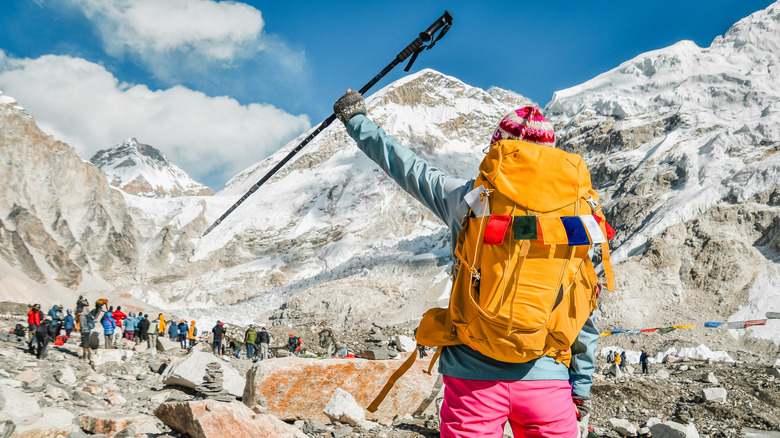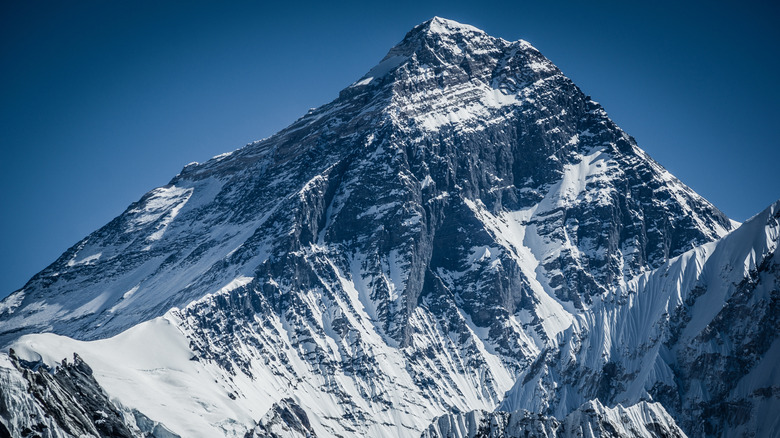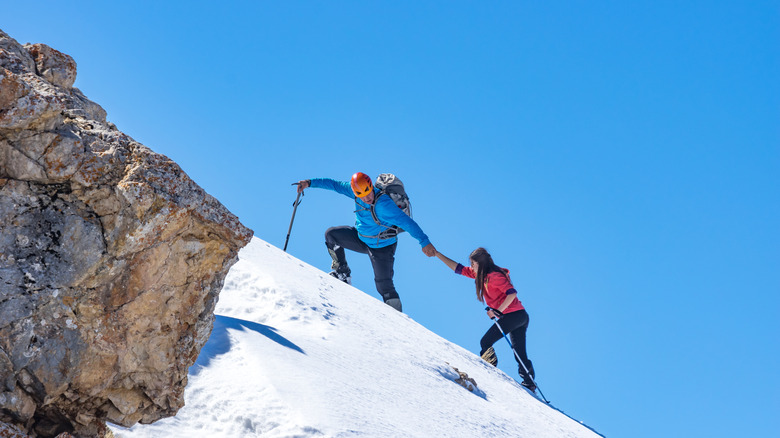What Mount Everest's 'Death Zone' Actually Feels Like, According To Climbers
We may receive a commission on purchases made from links.
Climbing Mount Everest is a bucket list event that defies sensibility but still attracts thrill-seekers despite its risks. The mountain's dangerous weather puts hikers and basecamp trekkers in danger, not just mountaineers: the summit rises 29,032 feet above sea level and can take up to eight weeks to climb from Base Camp 1, which itself requires a demanding trek to reach but is one of Nepal's most incredible hikes. At least 330 people have died attempting Everest, from hypothermia, avalanches, falls, hypoxia (oxygen deprivation), and altitude sickness, most occurring in the aptly-named "death zone." This infamous, almost 3,000-foot ascent is the final push before the peak, and begins at 26,247 feet (or nearly 5 miles) elevation, where Base Camp 4 is located.
One of the most interesting facts about Mount Everest is that to reach the peak, trekkers repeatedly ascend and descend between camps to acclimate their bodies before entering the death zone. As climbers ascend, oxygen levels drop sharply. As oxygen thins, the body begins to deteriorate – muscles shrink, vital organs strain, and cognitive ability declines – almost as if you're lethally drunk. Frostbite, hypothermia, and snow blindness are also constant risks. Experts warn that climbers should spend no more than 16 to 20 hours in the death zone.
A viral 2025 TikTok video captured this danger firsthand. Teen Australian climber Bianca Adler, fresh from four days in the death zone, sat in a tent at Camp 2, her face rash-covered and lips chafed, looking utterly exhausted. "I feel horrible," she said, straining to speak and struggling to breathe. "My throat and my lungs — I'm so out of breath." She later revealed she had developed deadly high-altitude pulmonary edema (HAPE), which filled her lungs with fluid.
The body starts shutting down
Preparing to enter Everest's death zone — aka "the point of no return" — is vital; the body can only survive there briefly. Most climbers use supplemental oxygen, but even that only delays the inevitable effects of extreme altitude. Some have compared the experience and the effects the body endures to being in outer space, only worse.
Bianca Adler stayed in the death zone longer than 90% of climbers, attempting to summit for seven hours through a severe windstorm before retreating to Camp 4. Over four days, Adler tried to summit twice more but failed. "I just felt awful. Just being so high up destroys your body," she recalled in an interview with an Australian news outlet. "Your bodily functions are a lot slower, I felt weak." It took a month for Adler to recover from HAPE.
In 2013, filmmaker and mountaineer Elia Saikaly described his own experience filming in the death zone. He details his terror in trying to sleep after his oxygen mask failed one night at camp, and his subsequent hallucinations: "Magnetic waves are pulsing and pulling me deeper into my mind. There is a bright light ahead seducing me and attempting to convince me to surrender to the pull into the land of the ever-dormant." Saikaly woke up coughing uncontrollably, calling it "the most terrifying moment of my life." He goes on to detail the mind-over-matter effort he maintained while summiting and filming — which required even more effort — and his encounter with a dead climber. "I can feel my body shutting down," he described. "I feel dead inside." When he finally reached the summit, he wrote: "My heart is racing, and my breathing is out of control," he wrote. "It's all mental at this point."
Everyone adapts differently to high altitude
Scientists are studying how human adaptation to altitude varies with factors like age and biological sex. People born at high elevations, like the Himalayan Sherpas, may have genetic advantages for retaining oxygen — but there's no precise altitude at which a body suddenly fails. Even Sherpas aren't immune to Everest's extremes. In 2024, the Nepalese Army spent nearly two months recovering five bodies from the death zone. "It was very tough," recalled Tshiring Jangbu Sherpa to the BBC. "I vomited sour water many times. Others kept coughing and others got headaches because we spent hours and hours at very high altitude."
There's no clear physical "moment" when you pass the 26,247-foot threshold into Everest's death zone. Mountaineer David Breashears described the experience as "running on a treadmill and breathing through a straw." On Reddit, mountaineers discussed death zone-level altitudes. "It's nothing defined by a line, everyone adapts differently ... You can feel worse at 7500m or such depending on how your physiology works," noted u/Sherpa_8000. "It's a very personalised thing. But high altitude makes you slow, your brain fries, and it takes every ounce of determination and stamina to keep going."
Another climber, u/BootsieHamilton, calls the death zone: "the height above which one no longer fully recovers while resting. Can't get enough calories, can't recover from exertion." One called it "torturous," adding, "Even resting is a chore ... You start to suffer and it just gets worse, until you simply can't really breath[e] anymore." Jon Krakauer, a journalist who attempted to summit with a fatal group in 1996, summed up the zone's gravity in his memoir, "Into Thin Air": "Above 26,000 feet, moreover, the line between appropriate zeal and reckless summit fever becomes grievously thin. Thus the slopes of Everest are littered with corpses."


